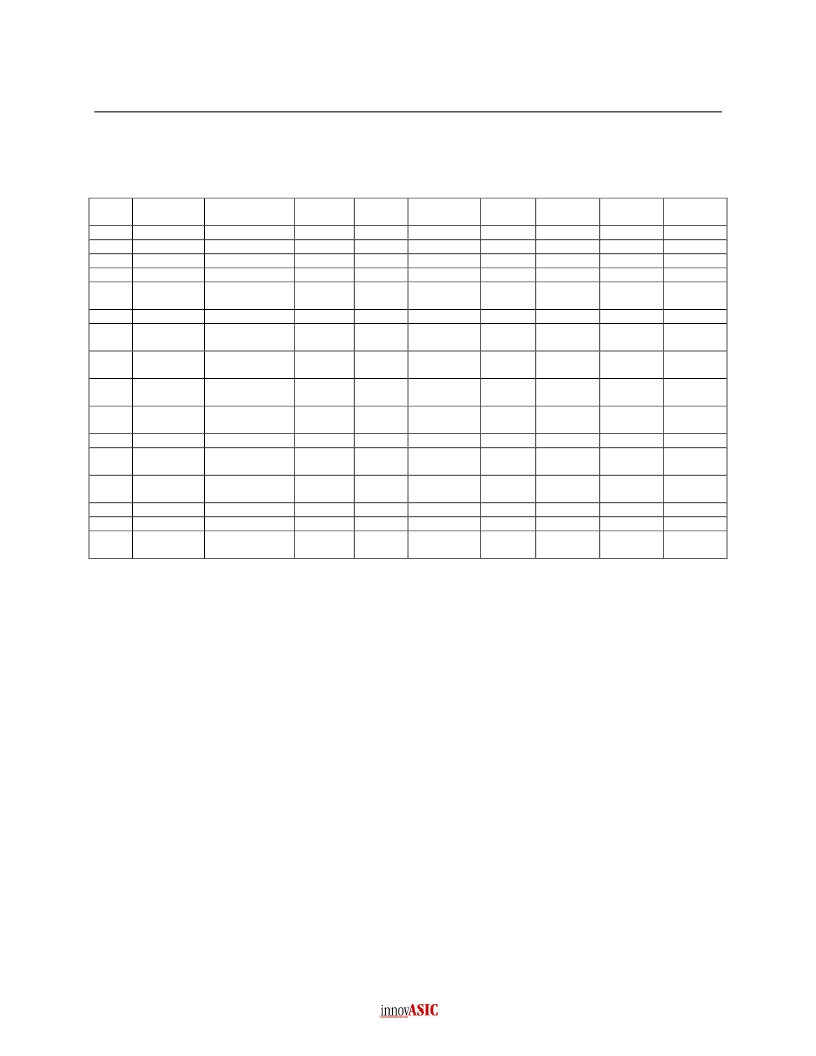- 您現(xiàn)在的位置:買(mǎi)賣(mài)IC網(wǎng) > PDF目錄379201 > IA2910A-CLC44M (Innovasic Semiconductor) Microprogram Controller PDF資料下載
參數(shù)資料
| 型號(hào): | IA2910A-CLC44M |
| 廠商: | Innovasic Semiconductor |
| 英文描述: | Microprogram Controller |
| 中文描述: | 微程序控制器 |
| 文件頁(yè)數(shù): | 7/19頁(yè) |
| 文件大?。?/td> | 162K |
| 代理商: | IA2910A-CLC44M |
第1頁(yè)第2頁(yè)第3頁(yè)第4頁(yè)第5頁(yè)第6頁(yè)當(dāng)前第7頁(yè)第8頁(yè)第9頁(yè)第10頁(yè)第11頁(yè)第12頁(yè)第13頁(yè)第14頁(yè)第15頁(yè)第16頁(yè)第17頁(yè)第18頁(yè)第19頁(yè)

Page 7 of 19
I
A2910A
Microprogram Controller
Preliminary
Data Sheet
Copyright
1999, InnovASIC Inc.
Customer SpecficIC Soutions
Instruction Set Description
Table 2
I(3:0)
Mnemonic
Name
Reg/cntr
contents
X
X
X
X
X
Fail
Y
0
PC
D
PC
PC
Fail
Stack
CLEAR
HOLD
HOLD
HOLD
PUSH
Pass
Y
0
D
D
D
PC
Pass
Stack
CLEAR
PUSH
HOLD
HOLD
PUSH
Reg/cntr
Enable
0
1
2
3
4
JZ
CJS
JMAP
CJP
PUSH
Jump Zero
Cond JSB PL
Jump Map
Cond Jump PL
Push/cond LD
cntr
Cond JSB R/PL
Cond Jump
Vector
Cond Jump
R/PL
Repeat Loop,
Cntr .NE. 0
Repeat PL, cntr
.NE. 0
Cond RTN
Cond Jump PL
& POP
LD Cntr &
Continue
Test End Loop
Continue
Three-Way
Branch
HOLD
HOLD
HOLD
HOLD
NOTE 1
PL
PL
MAP
PL
PL
5
6
JSRP
CJV
X
X
R
PC
PUSH
HOLD
D
D
PUSH
HOLD
HOLD
HOLD
PL
VECT
7
JRP
X
R
HOLD
D
HOLD
HOLD
PL
8
RFCT
.NE. 0
= 0
.NE. 0
= 0
X
X
F
PC
D
PC
PC
PC
HOLD
POP
HOLD
HOLD
HOLD
HOLD
F
PC
D
PC
F
D
HOLD
POP
HOLD
HOLD
POP
POP
DEC
HOLD
DEC
HOLD
HOLD
HOLD
PL
PL
PL
PL
PL
PL
9
RPCT
10
11
CRTN
CJPP
12
LDCT
X
PC
HOLD
PC
HOLD
LOAD
PL
13
14
15
LOOP
CONT
TWB
X
X
.NE. 0
= 0
F
PC
F
D
HOLD
HOLD
HOLD
POP
PC
PC
PC
PC
POP
HOLD
POP
POP
HOLD
HOLD
DEC
HOLD
PL
PL
PL
PL
NOTE 1:
If CCENn is LOW and CCn is HIGH, HOLD; ELSE LOAD.
X = Don’t Care
.NE. = Not equal
IA2910A Instruction Set
The IA2910A provides sixteen instructions which select the address of the next microinstruction to
be executed. Four of the instructions are unconditional – their effect depends only on the
instruction. Ten of the instructions have an effect which is partially controlled by an external, data-
dependent condition. Three of the instructions have an effect which is partially controlled by the
contents of the internal register/counter. The instruction set is shown in Table 2. Examples of the
Instruction Execution are illustrated in Figure 2. In this discussion it is assumed that CIN is tied
HIGH.
In the ten conditional instructions, the result of the data-dependent test is applied to CCn. If the
CCn input is LOW, the test is considered to have been passed, and the action specified in the name
occurs; otherwise, the test has failed and an alternate (often simply the execution of the next
sequential microinstruction) occurs. Testing of CCn may be disabled for a specific microinstruction
by setting CCENn HIGH, which unconditionally forces the action specified in the name; that is, it
forces a pass. Other ways of using CCENn include (1) tying it HIGH, which is useful if no
microinstruction is data-dependent; (2) tying it LOW if data-dependent instructions are never
相關(guān)PDF資料 |
PDF描述 |
|---|---|
| IA2910A-CLL44M | Microprogram Controller |
| IA2910A-PDW40C | Microprogram Controller |
| IA2910A-PDW40I | Microprogram Controller |
| IA2910A-PLC44C | Microprogram Controller |
| IA2910A-PLC44I | Microprogram Controller |
相關(guān)代理商/技術(shù)參數(shù) |
參數(shù)描述 |
|---|---|
| IA2910A-CLL44M | 制造商:INNOVASIC 制造商全稱:INNOVASIC 功能描述:Microprogram Controller |
| IA2910A-PDW40C | 制造商:INNOVASIC 制造商全稱:INNOVASIC 功能描述:Microprogram Controller |
| IA2910A-PDW40I | 制造商:INNOVASIC 制造商全稱:INNOVASIC 功能描述:Microprogram Controller |
| IA2910A-PLC44C | 制造商:INNOVASIC 制造商全稱:INNOVASIC 功能描述:Microprogram Controller |
| IA2910A-PLC44I | 制造商:INNOVASIC 制造商全稱:INNOVASIC 功能描述:Microprogram Controller |
發(fā)布緊急采購(gòu),3分鐘左右您將得到回復(fù)。